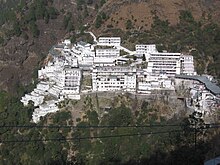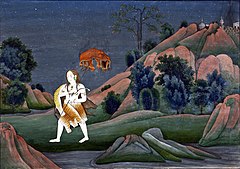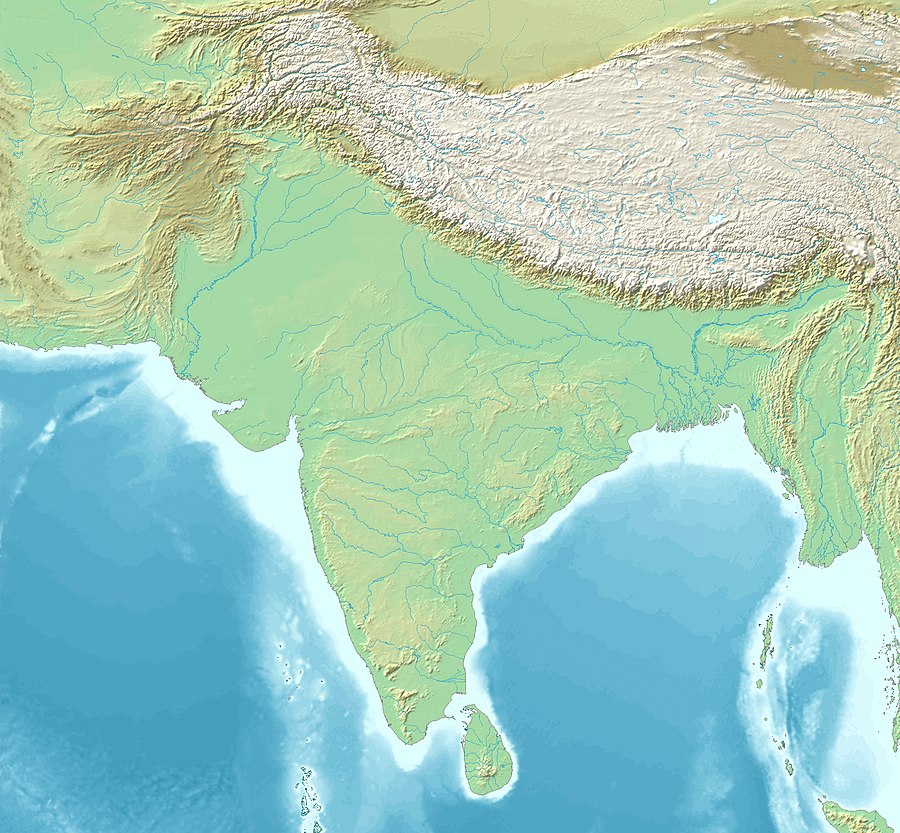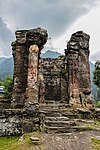
A | B | C | D | E | F | G | H | CH | I | J | K | L | M | N | O | P | Q | R | S | T | U | V | W | X | Y | Z | 0 | 1 | 2 | 3 | 4 | 5 | 6 | 7 | 8 | 9
This article has multiple issues. Please help improve it or discuss these issues on the talk page. (Learn how and when to remove these template messages)
|
| Part of a series on |
| Shaktism |
|---|
 |
|
|
The Shakti Pithas or the Shakti Peethas (Sanskrit: शक्ति पीठ, Śakti Pīṭha, seat of Shakti[1]) are significant shrines and pilgrimage destinations in Shaktism, the goddess-centric denomination in Hinduism. The shrines are dedicated to various forms of Adi Shakti. [a] Various Puranas such as Srimad Devi Bhagavatam state the existence of a varying number of 51, 52, 64 and 108 Shakti Pithas[2][3] of which 18 are named as Astadasha Maha (major) in medieval Hindu texts.[2]

Various legends explain how the Shakti Pithas came into existence. The most popular is based on the story of the death of the goddess Sati. Out of grief and sorrow, Shiva carried Sati's body, reminiscing about their moments as a couple, and roamed around the universe with it. Vishnu had cut her body into 51 body parts, using his Sudarshana Chakra, which fell on earth to become sacred sites where all the people can pay homage to the goddess. To complete this massively long task, Shiva took the form of Bhairava.

Most of these historic places of goddess worship are in India, but there are seven in Bangladesh, four in Nepal, three in Pakistan, and one each in Tibet, Sri Lanka[3] and Bhutan.[6] There were many legends in ancient and modern sources that document this evidence. A consensus view on the number and location of the precise sites where goddess Sati's corpse fell is lacking, although certain sites are more well-regarded than others.

Hinduism
Hindu literature
The Brahmanda Purana, one of the major eighteen Puranas mentions 64 Shakti Pithas of the goddess Parvati in the Bharat or Greater India including present-day India, Bhutan, Bangladesh, Nepal, Sri Lanka, some parts of Southern Tibet in China and parts of southern Pakistan. Another text which gives a listing of these shrines, is the Shakti Pitha Stotram, written by Adi Shankara, the 9th-century Hindu philosopher.[7]
According to the manuscript Mahapithapurana (c. 1690–1720 CE), there are 52 such places. Among them, 23 are located in the Bengal region, 14 of these are located in what is now West Bengal, India, 1 in Baster (Chhattisgarh), while 7 are in what is now Bangladesh.
Daksha yajna

According to legend, Brahma once conducted a huge yajna (ritual sacrifice), where all the prajapatis, deities, and kings of the world were invited. Shiva and Sati were also called on to participate in the yajna. All of them came for the yajna, and sat in the ceremonial place. Daksha came last. When he arrived, everyone in the yajna, with the exception of Brahma and Shiva, stood up, showing their reverence for him.[8] Brahma, being Daksha's father, did not rise. Shiva, being Daksha's son-in-law, and also due to the fact that he considered himself superior in stature to Daksha, remained seated. Daksha misunderstood Shiva's gesture, and considered this act an insult. Daksha vowed to take revenge on the insult in the same manner.[9]
Daksha performed a yajna with a desire to take revenge on Shiva. Daksha invited all the deities to the yajna, except Shiva and Sati. The fact that she was not invited did not deter Sati's desire to attend the yajna. She expressed her desire to Shiva, who tried his best to dissuade her from going. He relented at her continued insistence, Sati went to her father's yajna. However, Sati was not given her due respect at the yajna, and had to bear witness to Daksha's insults aimed at Shiva. Anguished, Sati cursed her father and self-immolated.
Enraged at the insult and death of his spouse, Shiva in his Virabhadra avatar destroyed Daksha's yajna and cut off his head. His anger not abated and immersed in grief, Shiva then picked up the remains of Sati's body and performed the Tandava, the celestial dance of destruction, across all creation. Frightened, the other deities requested Vishnu to intervene to stop this destruction. As a recourse, Vishnu used the Sudarshana Chakra on Sati's corpse. This caused various parts of Sati's body to fall at several spots across the world.[10]
The history of Daksha yajna and Sati's self-immolation had immense significance in shaping the ancient Sanskrit literature and influenced the culture of India. Each of the places on Earth where Sati's body parts were known to have fell were then considered as Shakti Pithas and were deemed places of great spiritual importance.[citation needed] Several stories in the Puranas and other Hindu religious books refer to the Daksha yajna. It is an important incident in both Shaivism and Shaktism, and marks the replacement of Sati with Parvati, and of the beginning of Shiva's house-holder (grihastāshramī) life from an ascetic. This event is ahead of the emergence of both of the couple's children, Kartikeya and Ganesha.[11]
Shakti Pithas
Each temple has shrines for Shakti and Kalabhairava, and most Shakti and Kalabhairava in different Shakti Pithas have different names.
Map of Shakti Pithas
List of 4 Adi Shakti Pithas
The mythological texts which include the Kalika Purana, recognize four Shakti Peethas as sites where most of the energy is. Vimala where the feet fell (Pada Khanda), Tara Tarini housing the breasts (Stana Khanda), Kamakhya, where the genitals fell (Yoni Khanda) and Dakshina Kalika, where the toes of right foot fell. These four temples originated from the lifeless body of Sati.[12]
Apart from these 4 there are 48 other famous pithas recognized by religious texts. According to the Pithanirnaya Tantra the 51 peethas are in the present day countries of India, Sri Lanka, Bangladesh, Nepal, Tibet, Bhutan and Pakistan. The Shivacharita besides listing 51 maha-peethas, speaks about 26 more upa-peethas. The Bengali almanac, Vishuddha Siddhanta Panjika too describes the 51 peethas including the present modified addresses. A few of the several accepted listings are given below.[13] In South India, Srisailam in Andhra Pradesh became the site for a 2nd-century temple.[14]
List of 18 Astadasha Maha Shakti Pithas
There are believed to be 64 locations. Adi Shankara's Asta Dasha Shakti Pitha Stotram mentions 18 locations known as the Maha Shakti Pithas.[15][16] Among these, the Shakti Pithas at Kamakhya, Gaya and Ujjain are regarded as the most sacred as they symbolize the three most important aspects of the Mother Goddess viz. Creation (Kamarupa Devi), Nourishment (Sarvamangala Devi/Mangalagauri), and Annihilation (Mahakali Devi).
Sharadha Peeth is currently in a ruined state.[17] Only ruins are found in these places. Its ruins are near the Line of Control (LOC)[18] between the Indian and Pakistani-controlled portions of the former princely state of Kashmir and Jammu. Instead, Sringeri Sharada Pitham, Sringeri in Karnataka even though not a Shakti Pitha, is this aspect of the goddess. It is believed that Goddess Sharada moved from her ruined temple in Kashmir to live in the new temple in Sringeri. Requests have been made by the Hindu community in Pakistan to the Pakistani government to renovate the temple, the issue being raised by former Indian Home minister L. K. Advani to the Pakistan authorities[19] as a confidence-building measure, by increasing the people-to-people cross-border interaction.[18]
In Skanda Purana
As per Sankara Samhita of Sri Skanda Purana,[20]
- Sri Sankari Pitham (Thirukonamalai, Sri Lanka)
- Sri Simhika Pitham (Simhala)
- Sri Manika Pitham (Draksharamam, Dakshavati)
- Sri Shadkala Pitham (Peethapuram)
- Sri Bhramaramba Pitham (Srisailam)
- Sri Vijaya Pitham (Vijayapura)
- Sri Mahalakshmi Pitham (Kolhapur)
- Sri Renuka Pitham (Mahur)
- Sri Kamakoti Pitham (Kanchipuram)
- Sri Kuchananda Pitham (Salagrama)
- Sri Biraja Pitham (Jajpur)
- Sri Sarala Pitham (Jhankad, Odisha)
- Sri Bhadreshwari Pitham (Harmyagiri)
- Sri Mahakali Pitham (Ujjain)
- Sri Vindhyavasini Pitham (Vindhya mountains)
- Sri Mahayogi Pitham (Ahicchatra)
- Sri Kanyaka Pitham (Kanya Kubja)
- Sri Vishalakshi Pitham (Varanasi)
- Sri Saraswati Pitham (Kashmir)
- Sri Abhirami Pitham (Padmagiri, Dindigul)
List of all Shakti Pithas
This section needs attention from an expert in Hinduism. The specific problem is: Listing confusion and unverifiable other information. (November 2019) |
This section is missing information about List of Shakti Peethas. The total listing is 108. (July 2022) |
In the listings[21][22][23][24] below:
- "Shakti" refers to the Goddess worshipped at each location, all being manifestations of Dakshayani, Sati; later known as Parvati or Durga;
- "Bhairava" refers to the corresponding consort, each a manifestation of Shiva;
- "Body Part or Ornament" refers to the body part or piece of jewellery that fell to earth, at the location on which the respective temple is built.
More details on this are available in the text 'Tantrachūḍamanī' where Parvati tells these details to her son Skanda.
| Sr. No. | Place | State in India/Country | Body part or ornament | Shakti | Bhairava | Image |
|---|---|---|---|---|---|---|
| 1 | A. Amarnath Temple, from Srinagar through Pahalgam 94 km by Bus, Chandanwari 16 km by walk B. Shri Parvat in Ladakh |
Jammu and Kashmir | A. Throat B. Anklet |
Mahamaya Devi | Trisandhyeshwar (Amarnath) | 
|
| 2 |
|
West Bengal | Lips | Phullara Devi | Vishveshwar |  
|
| 3 | Bahula at Ketugram, 8 km from Katwa, Purba Bardhaman | West Bengal | Left arm | Goddess Bahuladevi | Bhirukeshwar[25] | 
|
| 4 | Bakreshwar, on the banks of Paaphara river, 24 km distance from Siuri Town , district Birbhum, 7 km from Dubrajpur Rly. Station | West Bengal | Portion between the eyebrows | Mahishamardini devi | Vakranatheshwar | 
|
| 5 | Bhairavparvat, also known as Harsiddhi, at Bhairav hills on the banks of Shipra river in the city of Ujjaini. | Madhya Pradesh | Elbow | Avanti Devi | Lambkarneshwar | |
| 6 | Bhabanipur, located in the Upazila of Sherpur, Bogra, Rajshahi Division. Also located at Karatoyatat, it is about 28 km distance from the town of Sherpur. | Rajshahi Division, Bangladesh | Left anklet (ornament) | Aparna Devi | Vamaneshwar | 
|
| 7 | Biraja Temple at Jajpur, in Jajpur District | Odisha | Navel | Biraja Devi | Varaheshwar (Baraha) | 
|
| 8 | padmakshi Renuka Mandir, kawade,Alibag, Maharashtra | Maharashtra | Upper teeth | Tripura Sundari devi | Samhara Bhairaveshwar | |
| 9 | Muktinath Temple[26] | Nepal | Right cheek | Tulasi | Vishnu | 
|
| 10 | Goddess Bhadrakali on banks of Godavari in Nashik city (Saptashrungi) | Maharashtra | Chin (2 parts) | Bhadrakali devi | Vikritaksheshwar | 
|
| 11 | Hinglaj Mata Temple | Pakistan | Bramharandhra (Part of the head) | Kottari Devi | Bhimalochaneshwar | 
|
| 12 | Jayanti at Nartiang village in the Jaintia Hills district. This Shakti Pitha is locally known as the Nartiang Durga Temple. | Meghalaya | Left thigh | Jayanti Devi | Kramadishwar | 
|
| 13 | Jeshoreshwari Kali Temple | Bangladesh | Palms of hands and soles of the feet | Jashoreshwari | Chandeshwar | 
|
| 14 | Jwalaji, Kangra from Pathankot alight at Jwalamukhi Road Station from there 20 km | Himachal Pradesh | Tongue | Jwalamukhi (Ambika) | Unmatta Bhairaveshwar | 
|
| 15 | Kalipeeth, (Kalighat, Kolkata) | West Bengal | Right toes
Zdroj:https://en.wikipedia.org?pojem=Shakti_Peethas Text je dostupný za podmienok Creative Commons Attribution/Share-Alike License 3.0 Unported; prípadne za ďalších podmienok. Podrobnejšie informácie nájdete na stránke Podmienky použitia.
Analytika
Antropológia Aplikované vedy Bibliometria Dejiny vedy Encyklopédie Filozofia vedy Forenzné vedy Humanitné vedy Knižničná veda Kryogenika Kryptológia Kulturológia Literárna veda Medzidisciplinárne oblasti Metódy kvantitatívnej analýzy Metavedy Metodika Text je dostupný za podmienok Creative
Commons Attribution/Share-Alike License 3.0 Unported; prípadne za ďalších
podmienok. www.astronomia.sk | www.biologia.sk | www.botanika.sk | www.dejiny.sk | www.economy.sk | www.elektrotechnika.sk | www.estetika.sk | www.farmakologia.sk | www.filozofia.sk | Fyzika | www.futurologia.sk | www.genetika.sk | www.chemia.sk | www.lingvistika.sk | www.politologia.sk | www.psychologia.sk | www.sexuologia.sk | www.sociologia.sk | www.veda.sk I www.zoologia.sk |



















